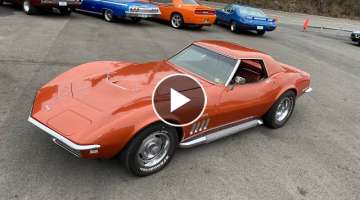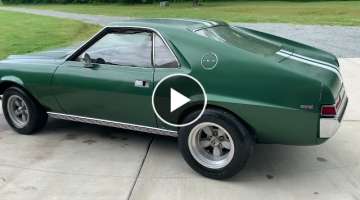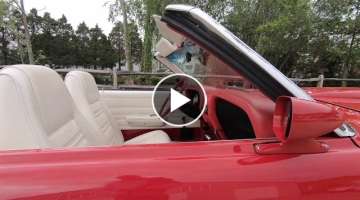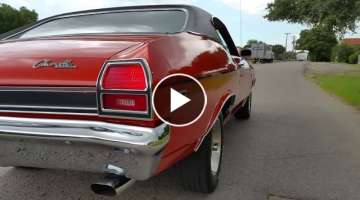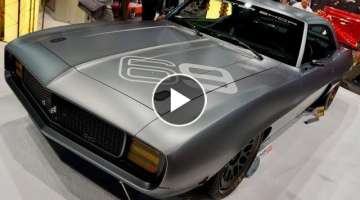1956 Chevrolet Bel Air
Chevrolet's legacy was established on its succession of popular models that continue to form the backbone of today's classic-car culture. Among them were the handsomely designed 1955 through 1957 'Shoebox' models, and while some prefer the subtle styling of the 1955 models, others prefer the more flamboyantly finned and trimmed 1957 models. Wedged between the two were the 1956 Chevys, a balance and blend of these two extremes.
Chevrolet's 1955 model lineup included the entry-level One-Fifty, the intermediate Two-Ten, and the top-of-the-line Bel Air. Body styles included a two-door hardtop, 2- and 4-door sedan, convertible, station wagon, and Nomad wagon. The Nomad was derived from a Corvette-based 'dream car' by Harley Earl's styling that was part of the GM Motorama display and toured during the early 1950s. The first release of cars under the Nomad name came during the 'Tri-Five Chevrolet' era of 1955-57. The 1955 Nomad shared its front-end design with its sibling, but from the cowl back, it was unique. The roof design was more fluid than the larger wagon in the lineup, and the rear hatch wore chrome strips, transforming the traditionally utilitarian station wagon design quite stylistic. It used the standard length of a Chevrolet passenger car and was marketed as a sedan with a utility-based rear cab.
The 1955 Bel Air was available with both six- and eight-cylinder power, with the six-cylinder two-door sedan being the least expensive, with a price of $1,670. The eight-cylinder version added approximately $320 to the base price. The highest 1955 Bel Air body style, and the most expensive production model that Chevrolet ever produced, as the eight-cylinder Nomad, at $2,571.
Chevrolet introduced the 265 cubic-inch V8 in 1955, featuring overhead valves, five main bearings, an 8.0:1 compression ratio, and delivering 162 horsepower at 4,400 RPM. A three-speed manual gearbox with a column-mounted gearshift was standard on all models, with overdrive being a $108 optional extra. The Powerglide two-speed automatic transmission was also optional, adding an additional $178 to the base price. The engine could also be upgraded with the optional 'power pack' that included a single four-barrel carburetor, dual exhaust, and a boost in power to 180 bhp at 4,600 RPM.
The 1956 Chevy models continued to be the One-Fifty, Two-Ten, and Bel Air, and powertrain options included the 235.5 CID inline-six rated at 140 horsepower and the 265 CID V8 with 162 horsepower. A full-width grille was among the new styling changes, along with rectangular front parking lamps, squarer headlamp hoods, and new bumpers and guards on all body styles except the station wagons. In the back were inward-angled dome-shaped taillamps surrounded by chrome ribbed decorative housing.
Each series wore nameplates of their respective models, and the Bel Air had emblems on the rear fenders and elaborate side moldings. It wore the most amount of chrome decoration, including around and between all windows, chrome wheel covers, and a slanting sash molding and chrome belt that traversed the body side. The interior contained a three-spoke steering wheel, and deep-pile carpeting on all body styles except for the Beauville nine-passenger station wagon, which had vinyl-coated rubber floor mats. Standard equipment included electric clocks, and a lighted and lockable glove compartment. The six-cylinder engine continued as the standard powerplant, and models equipped with the V8 wore V-shaped emblems below the crest ornaments on the hood and deck.
The convertible and Nomad body styles were exclusive to the Bel Air Series. The two-door sedan continued to be the least expensive body style with a base price of $2,025. The two-door hardtop listed for $2,175, the sedan at $2,070, and the four-door hardtop at $2,230. The convertible was $2,345 with the six-cylinder engine and $2,445 with the V8. The 9-passenger station wagon listed for $2,480 with the six and $2,580 with the V8. The Nomad was the most expensive in the 1956 Chevy lineup, costing $2,600 for the six and
The three-speed manual remained standard, with the overdrive and Powerglide two-speed automatic optional. All 1956 Chevy production cars rode on a 115-inch wheelbase platform with an overall length of 200.8 inches for the station wagons and 197.5 inches for the other body styles. The station wagons rested on 6.70 x 15 six-ply tires, while other models were equipped with 6.70x15 four-ply tires. The 7.10x15 four-ply was optional.
While some feared that Harley Earl's healthy dose of chrome was overdone, the buying public approved, and Chevrolet's market share improved from 16 to 28 percent. With 1,574,740 vehicles produced in 1956 and 1,621,004 sales, Chevrolet was the number one automaker in America. The combined Bel Air production of 699,053 represented approximately 45 percent of Chevrolet's 1956 production. The four-door sedan was the most popular body style within the Bel Air lineup, with 269,798 sales. The two-door hardtop had 128,382 sales, the two-door sedan with 104,849 sales, and the four-door hardtop with 103,602 sales. The convertible was one of the most popular of its body styles in America, with 41,268 examples sold. There were 13,268 examples of the 9-passenger station wagon built and 7,886 of the range-topping Nomad.
VIDEO
Facebook Comments











